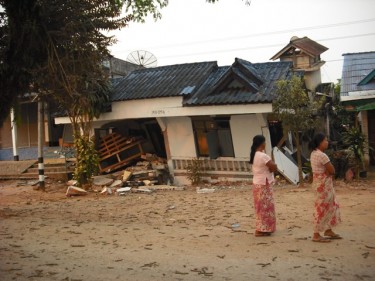A 6.8 magnitude earthquake hit the northern Shan State in Myanmar on Thursday, and according to a state-run TV report, the death toll has increased to 74 people, and the number of injured has climbed past 100 people.
According to an updated report from Weekly Eleven, several aftershocks have been recorded in areas near the eastern Shan State spreading fear among the residents. One resident in Oak Kyin village said on March 26, around 12pm:
There was another earthquake last night and one this morning also. I don't dare to stay in my house anymore. The shaking is felt more because my house is ground-based. Nothing can be predicted because it is a nature event. I will let fate decide.
Residents also said that because of the earthquake, the death toll in Tarchileik, Tarle, Nar Yaung village, Mine Lin village, and Mine Koe village is estimated to be more than a hundred, with Mine Lin village having the most number of casualties.
In the same report by Weekly Eleven, an aid worker described the situation in Tarle:
Wounded people have been sent to Tarchileik Hospital and Mine Phyat Hospital. Aid groups from Tarchileik and Kyaing Tong have based their camps in Tarle. I can say that the situation has calmed down a little. Reconstructions have begun. Rehabilitation camps have been opened in Tarle and Nar Yaung village.
An aid worker who went to Tarle, one of the worst-hit areas, was interviewed by The Irrawaddy:
I arrived in Tarle around 10am. Most of the 3-storey buildings on the side of the road only has 2 stories now. Many 2-storey buildings have also collapsed. Monasteries were also included in those collapsed buildings. Some of these buildings are more than 20 years old, so it made things worse.
Not only residents of Tarle, but also the residents in Tarchileik had to sleep on tarpaulins. When I arrived in Tarle, I saw that some people were clearing the things at their house by themselves. Some were crying in front of relative's houses. I also saw some crying because they lost their relatives. I couldn't ask them anything. I should say some were lucky to be alive.
The government hasn't done anything yet. Some were sent to hospitals. But I didn't go to the hospital so I don't know what's happening there. As far as I see, I see that there are about 60 deaths in Tachileik. There were about 20-30 deaths there (in Tarle). Death toll would be above that.
I donated some materials, instant noodles and water. I gave all of them to residential officials. I don't know what they will do with these things. They have opened temporary shelters. Those who have relatives go and live at their house.
Now, the highway has been closed temporarily. They said that it will be going under maintenance.
Another aid worker from Tarchileik said:
The earthquake happened on March 24, 8:25pm. Some hours after, officials from Tarchileik came and asked me to volunteer so I went with them. I arrived in Tarle at midnight.
On the road to Tarle, there is one big bridge. When we reached that place, our car cannot go forward anymore. So we had to cross the bridge on foot and continue on to Tarle. The road at the edge of the bridge had moved down about 5 feet. There was a great deal of destruction. With some houses, only the roof was visible and the whole house has went down into the ground.
What I had to do there was to send wounded people to Tarchileik hospital. There is a hospital at Tarle, but that hospital had also collapsed. So at first, we had to place the patients at the empty yard in front of the hospital and give them treatment. Afterwards, they were carried by stretchers to the car at the other side of the bridge. The walk there takes about 15 minutes.
When we get to the other side of the bridge, we can't immediately send the patients to the hospital. Because we didn't have many available stretchers, we had to take that stretcher back to the hospital and carry another patient. There wasn't enough cars so we couldn't send one patient to Tarchileik hospital with one car. Therefore, the patient who was sent first to the car had to wait for other patients to arrive.
Another thing is we had to wait for many levels of officials’ approval for clearance in order for the car to leave to the hospital. That wastes a lot of valuable time. In the car I had to drive, one patient died when we were about to reach Tarchileik Hospital. There were people who had survived the earthquake, but died when they shouldn't have because they were not treated in time for their sustained injuries. It really makes me sad.
U Win Swe, president of Myanmar Geological Society, said to Weekly Eleven:
In the past, strong earthquakes have occured in areas around Shan State. But it has been awhile since that has happened. Earthquakes usually reoccur in areas that were previously hit before. It was only a matter of how frequent. In areas among the quake fault line, there is a tendency for after shocks to follow after a big earthquake has hit.
He also warned that because the Indian plate keeps pushing into Asia, Myanmar should be on alert for earthquakes in the future.








1 comment